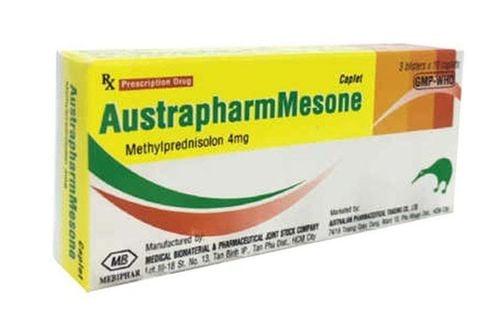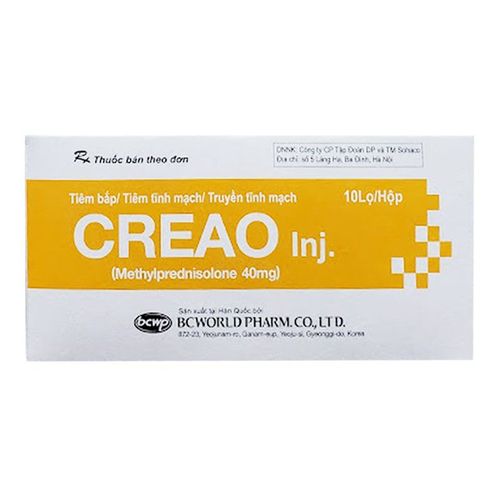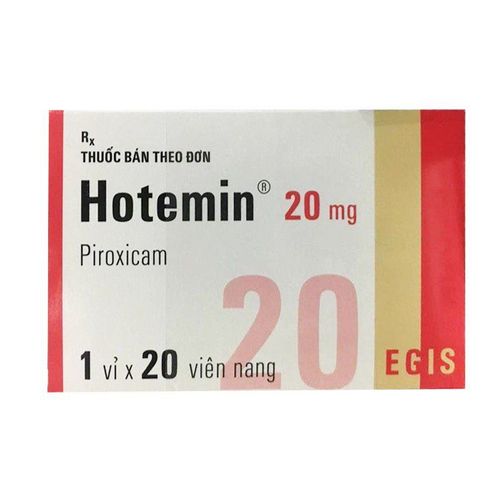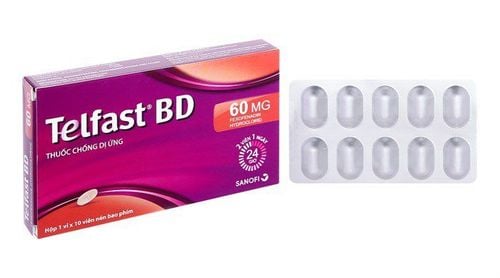This is an automatically translated article.
Tanametrol has the main active ingredient Methylprednisolone, a corticosteroid used in the treatment of many diseases. The article will provide some information about the most effective and safe uses and doses of Tanametrol.1. What is Tanametrol?
Main ingredients Methylprednisolone with many different strengths such as Tomethrol 4mg and Tomethrol 16mg. Tanametrol is used to treat endocrine disorders, rheumatism, arteritis, ophthalmologic diseases, dermatological diseases, allergies, respiratory diseases, hematologic diseases, cancers, intestinal diseases, other diseases such as tuberculous meningitis (with appropriate anti-tuberculosis chemotherapy) and organ transplantation. Methylprednisolone is a synthetic glucocorticoid with anti-inflammatory or immunosuppressive effects. The anti-inflammatory effect is due to the reduction of production and activity of anti-inflammatory chemical mediators (such as Histamine, Prostaglandin, Leucotrien,...), so the drug has the effect of reducing the initial manifestations of inflammatory process. Methylprednisolone inhibits incoming leukocytes from adhering to the damaged vessel wall and migrating to the injured area, reducing vascular permeability, so that fewer white blood cells reach the damaged area. This effect helps the drug to reduce extravasation, reduce symptoms of pain, swelling, and edema.Tanametrol is commonly used in an esterified or non-esterified form to treat indicated conditions. Because Prednisolone has been methylated, Methylprednisolone has only minimal mineralocorticoid activity, so it is not suitable for the treatment of adrenal insufficiency alone. If Methylprednisolone is used in the treatment of adrenal insufficiency, a mineralocorticoid must be added. The immunosuppressive properties are due to inhibition of the toxic effect of the antigen-antibody complexes that cause allergic vasculitis in the skin. By inhibiting the action of lymphocytes, target cells, and macrophages, corticosteroids have reduced allergic contact dermatitis reactions. In addition, corticosteroids also have the ability to prevent T lymphocytes and macrophages from reaching target cells.
2. Indications for the drug Tanametrol
Tanametrol is indicated for use in the following cases:Endocrine disorders: Primary or secondary adrenal insufficiency, congenital adrenal cortical hyperplasia. Rheumatic disorders: Rheumatoid arthritis, rheumatoid arthritis, juvenile chronic arthritis,. Collagen disease/arteritis: Systemic lupus erythematosus, systemic dermatomyositis, polymyalgia rheumatica, rheumatic fever with severe heart inflammation, giant cell arteritis. Dermatological disease: Common autoimmune disease (causes skin blisters). Allergies: Perennial allergic rhinitis, bronchial asthma, drug hypersensitivity reactions, serum sickness, allergic contact dermatitis. Ophthalmic disease: Optic neuritis, anterior uveitis, posterior uveitis Respiratory tract disease: Pulmonary sarcoid, pulmonary tuberculosis or acute miliary TB (with appropriate anti-tuberculosis chemotherapy). Hematologic disorders: Hemolytic anemia (autoimmune), ITP (idiopathic thrombocytopenic purpura). Cancer: Malignant lymphoma, acute leukemia, and lymphatic disease Intestinal disease: Crohn's disease, ulcerative colitis Other conditions: Organ transplant, tuberculous meningitis (with appropriate anti-tuberculosis chemotherapy) .
3. Dosage of Tanametrol
Tanametrol is taken orally. The average total daily dose is recommended as a single dose or in divided doses (except in cases where the effect is doubled on alternate days). Undesirable effects of Methylprednisolone can be reduced by using the lowest effective dose for the shortest time.For elderly patients: If the drug is given to elderly patients, especially if used long-term, the patient should be warned of serious consequences that may occur in the elderly, especially diabetes. diabetes, osteoporosis, high blood pressure, susceptibility to infection.
For children: The dose of Tanametrol for children should be adjusted based on clinical response and medical advice. Drug therapy should be limited to the minimum dose for the shortest duration.
Recommended dose:
| Chỉ định | Liều ban đầu hằng ngày |
|
Viêm khớp dạng thấp · Nặng · Trung bình nặng · Trung bình · Trẻ em |
12 - 16 mg 8 - 12 mg 4 - 8 mg 4 - 8 mg |
| Viêm da cơ toàn thân | 48 mg |
| Lupus ban đỏ hệ thống | 20 - 100 mg |
| Sốt thấp khớp cấp tính | 48 mg cho đến khi chỉ số ESR bình thường trong vòng một tuần |
| Bệnh dị ứng | 12 - 40 mg |
| Hen phế quản | Lên đến 64 mg liều duy nhất/ cách ngày lên đến tối đa 100 mg |
| Bệnh mắt | 12 - 40 mg |
| Rối loạn huyết học, bệnh bạch cầu | 16 - 100 mg |
| U lympho ác tính | 16 - 100 mg |
| Viêm loét đại tràng | 16 - 60 mg |
| Bệnh Crohn | Có thể dùng tới 45 mg trong giai đoạn cấp tính |
| Cấy ghép nội tạng | Lên đến 3,6 mg/kg/ngày |
| Sarcoid phổi | 32 - 48 mg cách ngày |
| Bệnh tự miễn thông thường | 80 - 360 mg |
4. What to do in case of an overdose of Tanametrol?
Methylprednisolone use should not be stopped suddenly, the dose should be reduced slowly over a period of time to reduce side effects. There is no clinical syndrome of acute overdose with methylprednisolone. Data on acute toxicity and/or death following glucocorticoid overdose are rare. In case of Methylprednisolone overdose, there is no specific antidote. Patients will receive supportive and symptomatic treatment.5. Tanametrol side effects
When using Tanametrol, patients may experience undesirable effects (ADRs) including:Frequency not determined:
Cardiovascular: Bradycardia, arrhythmia, heart failure, enlarged heart, circulatory shock, edema, embolism, hypertension, hypertrophic cardiomyopathy (in neonates), syncope, tachycardia, thromboembolism, thrombophlebitis, vasculitis Central nervous system: Depression, euphoria, headache, increased intracranial pressure, insomnia, irritability, myasthenia gravis, neuritis, neuropathy, paresthesia, psychosis, convulsions, sensory disturbances, dizziness Facial Dermatology: Acne, atopic dermatitis, alopecia, skin atrophy, epidermal thinning, erythema, exfoliative, facial erythema, hyperpigmentation, hypopigmentation, skin atrophy, skin rash, hair thinning, urticaria Endocrine and metabolic: Adrenal suppression, Cushing's syndrome, impaired glucose tolerance, diabetes mellitus, fluid retention, growth inhibition (children), hirsutism, HPA axis suppression, increased blood sugar, hyperlipidemia, hypokalemia, increased insulin resistance (increased demand for i.e. insulin or oral hypoglycemic agents in diabetes), menstrual disorders, protein catabolism, sodium retention, weight gain Gastrointestinal: Abdominal distention, bladder dysfunction, carbohydrate intolerance, gastrointestinal bleeding , gastrointestinal perforation, hiccups, increased appetite, intestinal perforation (especially in patients with inflammatory bowel disease), nausea, pancreatitis, peptic ulcer, spermatogenesis disorder (decreased number spermatozoa), esophagitis Hematologic: Leukocytosis (transient), malignant neoplasm (secondary), petechiae Liver: Enlarged liver, elevated liver enzymes Infection: Increased susceptibility to infection, infection Infection (ophthalmology), aseptic abscess Site: Injection site infection Neuromuscular and skeletal: Muscular atrophy, arthropathy, aseptic necrosis of the femoral head, fracture, Charcot's arthropathy, bone atrophy, osteoporosis bone, tendon rupture, steroid myopathy, vertebral compression fracture Ophthalmology: Blindness, intraocular pressure detachment, glaucoma, cataract, visual impairment Respiratory: Pulmonary edema, rhinitis Other: Anaphylactic reaction , edema h, hypersensitivity reactions, tissue shedding, impaired wound healing
6. Note when using Tanametrol
Adrenal suppression: May cause hypercortisolism or suppression of the hypothalamic-pituitary-adrenal (HPA) axis, especially in young children or in patients receiving high doses for long periods of time. HPA axis suppression can lead to adrenal dysfunction. Corticosteroid withdrawal should be done slowly and carefully. Particular care should be taken when patients are switched from systemic corticosteroids to inhaled products due to possible adrenal insufficiency, including an increase in allergic symptoms. Adult patients taking > 20 mg of Prednisone daily (or equivalent) may be most susceptible. Anaphylactic Reactions: Rare cases of anaphylaxis have been observed in patients receiving corticosteroids. Skin Changes: Avoid injection or leakage into the dermis, dermal and/or subcutaneous indentation may occur at the injection site. Avoid deltoid muscle injection, subcutaneous atrophy may occur. Hepatic Effects: High doses of IV Methylprednisolone (usually 1g/day in adults) can cause a rare (rare) form of toxic acute hepatitis, which can lead to severe liver damage, acute liver failure, and liver failure. count and death. Onset time can be several weeks or longer. Discontinue Methylprednisolone if toxic hepatitis develops. Avoid high doses in patients with a history of toxic hepatitis due to methylprednisolone. Immunosuppressive: Prolonged use of corticosteroids may increase the incidence of secondary infections, trigger latent infections, mask acute infections (including fungal infections), prolong or worsen viral or parasitic infections, or limited response to vaccines. Corticosteroids should not be used to treat ocular herpes simplex, cerebral malaria, fungal infections, or viral hepatitis. Close monitoring is required in patients with latent and/or reactive TB, limiting use to active TB (terminal or disseminated TB only in combination with antituberculosis therapy). ). Use with extreme caution in patients with strongyloidiasis. Kaposi's sarcoma: Prolonged treatment with corticosteroids has been associated with the development of Kaposi's sarcoma, discontinuation may lead to clinical improvement. Myopathy: Cases of acute myopathy have been reported with high-dose corticosteroids. The disease usually occurs in patients with neuromuscular transmission disorders, which may involve the eyes and/or respiratory muscles. Creatine kinase should be monitored during treatment. Psychiatric Disorders: Use of corticosteroids may cause psychiatric disturbances, including euphoria, insomnia, personality changes, major depression, or other psychotic manifestations. Pre-existing psychiatric conditions may be aggravated by corticosteroid use. Septic arthritis: May occur as a complication of parenteral therapy, requiring appropriate antibiotic therapy as required. Cardiovascular disease: Use with caution in patients with heart failure and/or hypertension because of association with fluid retention, electrolyte disturbances and hypertension. Use with caution in patients after acute myocardial infarction. Diabetes: Corticosteroids should be used with caution in patients with diabetes because they can alter glucose production and regulation leading to hyperglycemia. Gastrointestinal disease: Use with caution in patients with gastrointestinal diseases (diverticulitis, small bowel anastomosis, active or latent peptic ulcer, ulcerative colitis, abscess or infection). other pyogenic) due to the risk of perforation. Hepatic impairment: Use with caution in patients with hepatic impairment, including cirrhosis as long-term use has been associated with fluid retention. Eye disease: Use with caution in patients with cataracts and/or glaucoma. Osteoporosis: Use with caution in patients with osteoporosis. High-dose and/or long-term corticosteroid use is associated with an increased risk of bone loss and osteoporosis-related fractures. Renal impairment: Use with caution in patients with renal impairment because fluid retention may occur. Seizure disorders: Methylprednisolone should be used with caution in patients with a history of seizure disorders. Elderly: Use with caution in the elderly. It should be used in the smallest effective dose for the shortest period of time. Children: The drug may affect growth, therefore caution should be taken. Pregnant women: Methylprednisolone is the preferred oral corticosteroid for the treatment of maternal conditions during pregnancy because of enzymes. of the placenta restricts migration to the embryo). When systemic corticosteroids are required during pregnancy for the treatment of rheumatic disorders, preference should be given to non-fluorinated corticosteroids such as methylprednisolone. High doses and long-term use should be avoided. Lactation: The manufacturer notes that when used systemicly, corticosteroids have the potential to cause adverse effects in nursing infants (eg, growth inhibition, interference with endogenous corticosteroid production). and therefore it is recommended that a decision should be made whether to discontinue breastfeeding and take into account the importance of treatment to the mother. Corticosteroids are generally considered to be acceptable in nursing patients when used in usual doses; however, the nursing infant should be closely monitored. In summary, Tanametrol is used to treat endocrine disorders, rheumatism, collagen disease/arteritis, ophthalmic disease, dermatological disease, allergy, respiratory disease, hematology, cancer, diabetes bowel, other diseases such as tuberculous meningitis and organ transplants. If not used correctly, the drug can cause many very dangerous side effects. Therefore, the patient should only use the drug exactly as prescribed by the doctor.Please dial HOTLINE for more information or register for an appointment HERE. Download MyVinmec app to make appointments faster and to manage your bookings easily.













